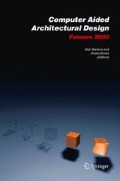Abstract
The objective of this paper is to evaluate the use of virtual reality as a potential decision-making tool to cognitively evaluate urban daylighting ambiences. This paper evaluates the solar effects visual perception in a real urban path in comparison to a virtual urban path in order to extract the characteristics of these effects and use them to figure out the necessary conditions for generating a physical and sensitive phenomena simulation. The comparison is based on questionnaires and interviews with participants on their judgements on sunlight during their walk through the chosen path. Our results highlight the relation between perception and the context of the urban environment, and prove that -in spite of its limits- virtual reality is able to simulate a large part of real solar effects.
Access this chapter
Tax calculation will be finalised at checkout
Purchases are for personal use only
Preview
Unable to display preview. Download preview PDF.
References
Augoyard, Jean François. 1998. The cricket effect. Which tools for the research on sonic urban ambiences? In Stockholm, Hey Listen!. 1–8. Stockholm: The Royal Swedish Academy of Music and the Authors.
Azpiazu, A., C. Pedrinaci, and A. Garcìa-Alonso. 2004. A new paradigm for virtual reality: The guided visit trough a virtual world. In IEEE VRIC 2004 Proceedings, ed. Simon Richir, and Bernard Tavarel: 181–186. Laval: ISTIA.
Billger, Monica and Ilona Heldal. 2003. Virtual Environments versus a Full-Scale model for examining colours and space. In Proceedings of Virtual Concept 2003, ed. D. Couteillers et al.: 249–256. Biarritz: ESTIA.
Bishop, Ian D., JoAnna R. Wherrett, and David R. Miller. 2001. Assessment of path choices on a country walk using a virtual environment. Landscape and urban planning 52: 225–237.
Charton, Virgil. 2002. Etude comparative de la perception d’ambiances lumineuses en milieu réel et en milieu virtuel. Ph.D. Thesis, Ecole Nationale des Travaux Publics de l’Etat.
Cullen, Gordon. 1961. The Concise Townscape. London: the Architectural Press.
Follut, Dominique and Dominique Groleau. 2000. “Ambianscope” an immersion method to analyse urban environments. In Proceedings of Greenwich 2000 International Digital Creativity Symposium: Architecture, Landscape, Design, ed. C. Teeling: 139–148. London: University of Greenwich.
Fuchs, Philippe, and Guillaume Moreau. 2003. Le traité de la réalité virtuelle. vol. 1. 2nd ed. Paris: Les Presses de l’Ecole des Mines de Paris.
Jungman, Jean Paul. 1995. Ombre et Lumière: un manuel de tracé et de rendu qui considère. Paris: La Villette.
Lynch, Kevin. 1960. The Image of the City. Cambridge: MIT Press.
Moreau, Guillaume, and Philippe Fuchs. 2001. Virtual Reality in the design process: From design review to ergonomic studies. In ESS 2001: Simulation in Industry, ed. Norbert Giambiasi, and Claudia Frydman: 123–130. Marseille: SCS Europe.
Régnier, François. 1989. Annoncer la couleur. Nancy: IMQ.
Thibaud, Jean Paul. 2001a. Frames of visibility in public places. Awards for design, research and planning 14(1): 42–47.
Thibaud, Jean Paul. 2001b. La méthode des parcours commentés. In L’espace urbain en méthodes, eds. M. Grosjean, and J.P. Thibaud: 79–99. Marseille: Editions parenthèses.
Woloszyn, Philippe. 2003. Virtual Reality as an Ambience Production Tool. In Proceedings of IEPM’ 03 [CD-Rom]. Porto: FUCAM.
Author information
Authors and Affiliations
Editor information
Editors and Affiliations
Rights and permissions
Copyright information
© 2005 Springer
About this paper
Cite this paper
Tahrani, S., Jallouli, J., Moreau, G., Woloszyn, P. (2005). Towards a Virtual Reality Tool for Lighting. In: Martens, B., Brown, A. (eds) Computer Aided Architectural Design Futures 2005. Springer, Dordrecht. https://doi.org/10.1007/1-4020-3698-1_10
Download citation
DOI: https://doi.org/10.1007/1-4020-3698-1_10
Publisher Name: Springer, Dordrecht
Print ISBN: 978-1-4020-3460-2
Online ISBN: 978-1-4020-3698-9
eBook Packages: Earth and Environmental ScienceEarth and Environmental Science (R0)

